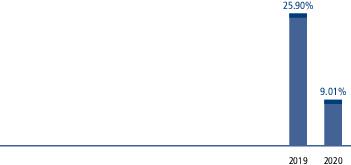Form 497K GOLDMAN SACHS TRUST
Summary
Prospectus
February 28, 2021
Goldman Sachs Rising Dividend Growth Fund
Class
P: GMHPX
Before you invest, you may want to review the Goldman Sachs
Rising Dividend Growth Fund (the “Fund”) Prospectus, which contains more information about the Fund and its risks. You can find the Fund’s Prospectus, reports to shareholders and other information about the Fund online at https://www.gsam.com/content/gsam/us/en/advisors/fund-center/summary-prospectuses.html. You can also get this information at no cost by calling 800-621-2550 or by sending an e-mail request to
[email protected]. The Fund’s Prospectus and Statement of Additional Information (“SAI”), both dated February 28, 2021, are incorporated by reference into this Summary Prospectus.
It is our intention that beginning on January 1, 2021, paper
copies of the Fund’s annual and semi-annual shareholder reports will not be sent by mail, unless you specifically request paper copies of the reports from the Fund or from your financial intermediary. Instead, the reports will be made
available on a website, and you will be notified by mail each time a report is posted and provided with a website link to access the report.
If you already elected to receive shareholder reports
electronically, you will not be affected by this change and you need not take any action. At any time, you may elect to receive reports and certain communications from the Fund electronically by calling the applicable toll-free number below or by
contacting your financial intermediary.
You may elect to
receive all future shareholder reports in paper free of charge. If you hold shares of the Fund directly with the Fund’s transfer agent, you can inform the transfer agent that you wish to receive paper copies of reports by calling toll-free
800-621-2550 for Institutional and Class R6 shareholders or 800-526-7384 for all other shareholders. If you hold shares of the Fund through a financial intermediary, please contact your financial intermediary to make this election. Your election to
receive reports in paper will apply to all Goldman Sachs Funds held in your account if you invest through your financial intermediary or all Goldman Sachs Funds held with the Fund’s transfer agent if you invest directly with the transfer
agent.
| Investment Objective |
The Goldman
Sachs Rising Dividend Growth Fund (the “Fund”) seeks long-term growth of capital and current income.
| Fees and Expenses of the Fund |
This table describes the fees and expenses that you
may pay if you buy, hold and sell shares of the Fund. You may pay other fees, such as brokerage commissions and other fees to financial intermediaries, which are not reflected in the table and Example below.

2 Summary
Prospectus — Goldman Sachs Rising Dividend Growth Fund
Annual Fund Operating Expenses
(expenses that you pay each year as a percentage of the
value of your investment)
| Class P | |
| Management Fees | 0.75% |
| Other Expenses | 0.15% |
| Total Annual Fund Operating Expenses | 0.90% |
| Fee Waiver and Expense Limitation1 | (0.19%) |
| Total Annual Fund Operating Expenses After Fee Waiver and Expense Limitation | 0.71% |
| 1 | The Investment Adviser has agreed to (i) waive a portion of its management fee in order to achieve an effective net management fee rate of 0.67% as an annual percentage of the Fund’s average daily net assets; and (ii) reduce or limit “Other Expenses” (excluding acquired fund fees and expenses, transfer agency fees and expenses, taxes, interest, brokerage fees, expenses of shareholder meetings, litigation and indemnification, and extraordinary expenses) to 0.014% of the Fund’s average daily net assets. These arrangements will remain in effect through at least February 28, 2022, and prior to such date the Investment Adviser may not terminate the arrangements without the approval of the Board of Trustees. |
3 Summary
Prospectus — Goldman Sachs Rising Dividend Growth Fund
4 Summary
Prospectus — Goldman Sachs Rising Dividend Growth Fund
5 Summary
Prospectus — Goldman Sachs Rising Dividend Growth Fund
| AVERAGE ANNUAL TOTAL RETURN |
| For the period ended December 31, 2020 | 1 Year | Since
Inception |
| Class P Shares (Inception 4/16/2018) | ||
| Returns Before Taxes | 9.01% | 9.81% |
| Returns After Taxes on Distributions | 7.50% | 3.42% |
| Returns After Taxes on Distributions and Sale of Fund Shares | 5.77% | 6.47% |
| S&P 500® Index (reflects no deduction for fees or expenses) | 18.34% | 15.48% |
After-tax returns are
calculated using the historical highest individual federal marginal income tax rates and do not reflect the impact of state and local taxes. Actual after-tax returns depend on an investor’s tax situation and may differ from those shown. In
addition, the after-tax returns shown are not relevant to investors who hold Fund Shares through tax-deferred arrangements such as 401(k) plans or individual retirement accounts.
6 Summary
Prospectus — Goldman Sachs Rising Dividend Growth Fund
[This page intentionally left blank]
7 Summary
Prospectus — Goldman Sachs Rising Dividend Growth Fund
[This page intentionally left blank]
8 Summary
Prospectus — Goldman Sachs Rising Dividend Growth Fund
DIVFOSUM2-21P
Serious News for Serious Traders! Try StreetInsider.com Premium Free!
You May Also Be Interested In
- Goldman Sachs Upgrades The TJX Companies (TJX) to Buy, 'best-in-class operator'
- Goldman Sachs Starts Victoria's Secret (VSCO) at Sell, 'Tough macro and ongoing competitive pressures'
- Marex Group (MRX) Prices 15.38M Share IPO at $19/sh
Create E-mail Alert Related Categories
SEC FilingsRelated Entities
Goldman SachsSign up for StreetInsider Free!
Receive full access to all new and archived articles, unlimited portfolio tracking, e-mail alerts, custom newswires and RSS feeds - and more!



 Tweet
Tweet Share
Share
